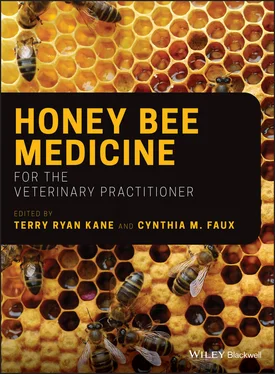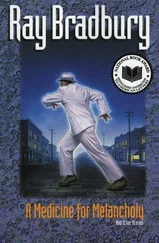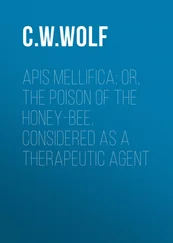24 Kirchner, W.H. (1993). Acoustical communication in honeybees. Apidologie 24 (3): 297–307.
25 Kronenberg, F. and Heller, H.C. (1982). Colonial thermoregulation in honey bees (Apis mellifera). Journal of Comparative Physiology 148: 65–76.
26 Kurze, C., Routtu, J., and Moritz, R.F.A. (2016). Parasite resistance and tolerance in honey bees at the individual and social level. Zoology 119: 290–297.
27 Leoncini, I., Le Conte, Y., Costaglioa, G. et al. (2004). Regulation of behavioral maturation by a primer pheromone produced by adult worker honey bees. Proceedings of the National Academy of Sciences of the United States of America 101 (50): 17559–17564.
28 Molnar, C. and Gair, J. (2015). Animal structure and function, digestive system Chapter 15.1. In: Concepts of Biology – 1st Canadian Edition. BCcampus, Victoria, B.C.
29 Nelson, C.M., Fondrk, M.K., Page, R.E. Jr., and Amdam, G.V. (2007). The gene vitellogenin has multiple coordinating effects on social organization. PLoS Biology 5 (3): e62.
30 Princen, S.A., Oliveira, R.C., Ernst, U.R. et al. (2019). Honeybees possess a structurally diverse and functionally redundant set of queen pheromones. Proceedings of the Royal Society B: Biological Sciences 286 (1905): 20190517.
31 Raymann, K. and Moran, N.A. (2018). The role of the gut microbiome in health and disease of adult honey bee workers. Curr Opin Insect Sci 26: 97–104.
32 Ritter, W. (2014). Bee Health and Veterinarians. World Organization for Animal Health. Paris: OIE.
33 Robinson, G.E. (1987). Regulation of honey bee age polyethism by juvenile hormone. Behavioral Ecology and Sociobiology 20: 329–338.
34 Seeley, T.D. (1992). The tremble dance of the honey bee: message and meanings. Behavioral Ecology and Sociobiology 31: 375–383.
35 Seeley, T.D. (1995). The Wisdom of the Hive: The Social Physiology of Honey Bee Colonies. Cambridge, MA: Harvard University Press.
36 Seeley, T.D. (2010). Honeybee Democracy. Princeton, NJ: Princeton University Press.
37 Slessor, K.N., Winston, M.L., and Le Conte, Y. (2005). Pheromone communication in the honeybee (Apis mellifera L.). Journal of Chemical Ecology 31 (11): 2731–2745.
38 Snodgrass, R.E. (1956). Anatomy of the Honey Bee. Ithaca, NY: Cornell University Press.
39 Stabentheiner, A., Kovac, H., and Brodschneider, R. (2010). Honeybee colony thermoregulation – regulatory mechanisms and contribution of individuals in dependence on age, location and thermal stress. PLoS One 5 (1): e8967.
40 Sullivan, J.P., Fahrbach, S.E., and Robinson, G.E. (2000). Juvenile hormone paces behavioral development in the adult worker honey bee. Hormones and Behavior 37 (1): 1–14.
41 Thom, C., Gilley, D.C., Hooper, J., and Esch, H.E. (2007). The scent of the waggle dance. PLoS Biol 5 (9): e228.
42 Tsujiuchi, S., Sivan‐Loukianova, E., Eberl, D.F. et al. (2007). Dynamic range compression in the honey bee auditory system toward waggle dance sounds. PLoS One 2 (2): e234.
43 Vidal‐Naquet, N. (2015). Honeybee Veterinary Medicine: Apis mellifera L. Sheffield: 5m Publishing.
44 Wigglesworth, V.B. (1972). The Principles of Insect Physiology. London: 7th ed. Chapman and Hall.
45 Winston, M.L. (1987). The Biology of the Honey Bee. Cambridge, MA: Harvard University Press.
Randy Oliver*
ScientificBeekeeping.com
The Queen's Function in the Hive
The queen bee holds a special mystique to beekeepers. Although she is treated as royalty, she is not responsible for much decision making in the colony. From a biological standpoint there is actually nothing particularly exceptional about her – she's a relatively normal reproductive female insect.
Practical application: The exceptional individuals in eusocial insect colonies are not their queens, but rather the non‐reproductive female worker caste (and subcastes) – the queen being the sole member of the female reproductive caste. All the functionally‐sterile worker caste members devote their energy and resources to support that singular egg‐producing “queen,” who acts not only as the “ovary” of the honey bee superorganism, but also as the pheromonal “gravitational center” of the colony (Figure 5.1 ).
The queen is indeed the heart of the hive – not only due to her being the mother of all the other members of the colony, but also by secreting pheromones that induce colony cohesiveness, suppress ovary development in the rest of the females, and perhaps most importantly, to provide an “honest signal” as to her reproductive status (as opposed to merely suppressing competitive egg laying) (Niño et al. 2013). Queen pheromone (actually a variable mixture of several pheromones) appears to also suppress the feeding of most female larvae, thus epigenetically resulting in them becoming functionally‐sterile “workers” rather than reproductive queens.
A young, well‐mated, healthy queen will attract a strong “retinue” of nearby nurse bees that offer her jelly, groom her, and transfer her pheromones to the rest of the members of the colony ( Figure 5.2). An experienced beekeeper can immediately recognize, by colony organization and temperament, whether it has a queen that is producing abundant queen pheromone.
Practical application: Despite her royal treatment and being the mother of all the workers in the hive, the queen enjoys no particular fealty from her functionally‐sterile daughters. She is entirely fungible, and the colony will replace her at the drop of a hat should it sense, via pheromonal or other cues, that either she or the colony is failing.
Queen Development and Performance
Queen Larval Development
A queen is reared in large, vertical cell as opposed to the smaller horizontal cell of a worker. All female larvae are fed essentially the same diet for the first 24 hours, up to which point any could potentially become a queen. After that, developmental paths switch, with larvae chosen by the nurses to be a queen being fed to excess, with much of the jelly not being consumed until after her cell is “sealed.”
Although the common conception is that queen larvae are fed a special “royal jelly,” whereas worker larvae are fed “worker jelly” and pollen, this explanation is controversial, especially considering how logistically difficult it would be for the nurse bees which are constantly moving. 1 The most parsimonious (but debatable) explanation is that the nurses adjust the proportions of the three components of jelly dependent upon the age and caste of the larva being fed. Those components are (i) a protein‐rich secretion from the hypopharyngeal glands, (ii) a lipid‐rich secretion from the mandibular glands, and (iii) the amount of nectar added. Queen larvae receive not only a far greater amount of jelly, but higher proportions of lipids and sugars (Winston 1987; Wang et al. 2016). Queen larvae thus grow more rapidly than do worker larvae, to a greater size, and emerge at an earlier age.
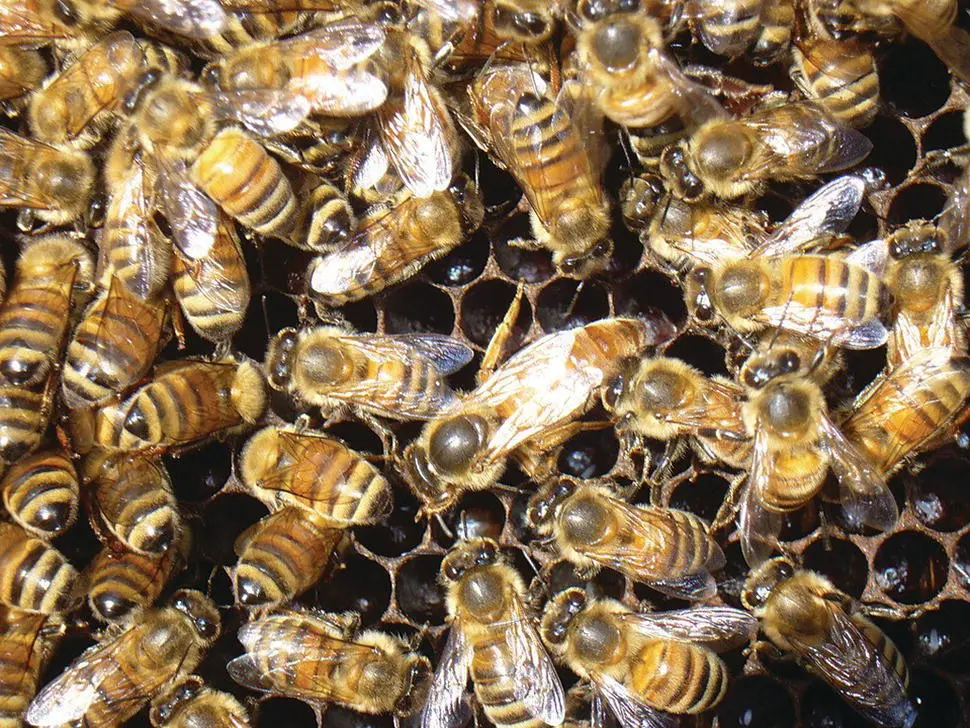
Figure 5.1 The queen functions not only as the ovary of the honey bee superorganism, but also as the pheromonal “heart” of the hive, critical for colony cohesiveness. In a rapidly‐growing colony, roughly a thousand of her daughters die each day from natural aging and mortality. Thus, in order to maintain colony growth, the queen must not only lay an adequate number of eggs to replace those lost workers, but also enough for population increase, as many as 1500 a day.
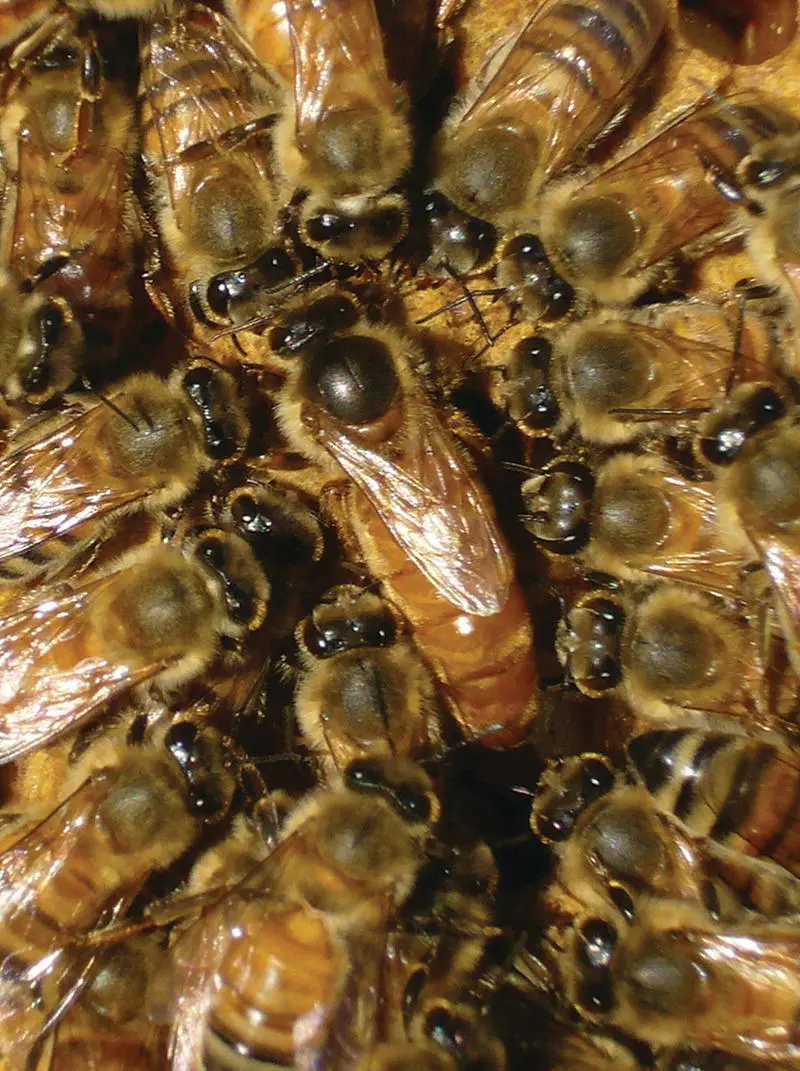
Figure 5.2 Whenever a “good” queen pauses on the comb, an ad hoc group of adjacent nurse bees will turn to face her, offering her food, and antennating her to pick up her pheromones (Collison 2017). This ring of attendants is called a “retinue.” Since the advent of varroa, some are suggesting that queens these days don't seem to attract retinues the way they used to. It is possible that this may correlate with what appear to be reports of greater rates of queen failure.
Читать дальше
